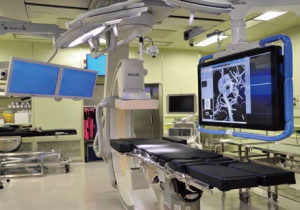Top > About Us > News Letter > A Hybrid Angiosystem
A Hybrid Angiosystem
Special Topic Increasing Treatment Options
A hybrid angiosystem was installed in the operating room of the University of Tokyo Hospital in April 2014.
This system is expected to promote the accuracy and safety of surgical procedures, and to increase treatment options.
What makes a hybrid angiosystem?
A “hybrid” system ingeniously combines the distinctive characteristics and performance of previously independent features. What are the components of a hybrid angiosystem? “Angio” is an abbreviation of “angiography,” which is performed by using an X-ray fluoroscope. In principle, angiography is conducted in an X-ray examination laboratory, which is separated from an operating room. As a large variety of therapeutic techniques have been developed, an increasing number of procedures—including catheterization—that require fluoroscopy-guided insertion of treatment tools into the body have been introduced, resulting in more treatments being conducted in an X-ray examination laboratory. Sufficient staff and equipment are indispensable to conduct various procedures safely in an X-ray examination laboratory. However, the limited resources available in an X-ray examination laboratory result in procedural limitations. The development of the hybrid angiosystem addresses these limitations by combining the functions of X-ray examination laboratories and operating rooms. The installation of the hybrid angiosystem in an operating room—rather than a laboratory—allows for stricter control of cleanliness levels; moreover, it brings together a multidisciplinary team of health care professionals including the surgeons who are in charge of treatment, anesthesiologists who are in charge of the systemic management of patients, nurses, biomedical equipment technicians and radiology technologists. Overall, such environments allow for treatments that are more complicated and that could not be conducted in ordinary examination laboratories.
High-performance X-ray fluoroscope
We have occasionally used a portable X-ray fluoroscope to help guide surgical procedures during surgery. However, the inferior performance of the portable X-ray fluoroscope, compared with an X-ray fluoroscope installed in the examination laboratory, results in blurred images, and produces only 2-dimensional views, which are not suitable for complicated surgery. The X-ray fluoroscope incorporated in the hybrid angiosystem can produce high-quality clear images and can be accurately controlled at 1-mm intervals. Subsequent image processing enables the internal vascular structure to be visualized as a 3-dimensional (3-D) image, allowing surgeons to quickly plan the surgical procedure.
The introduction of the hybrid angiosystem as a new treatment option
In September 2013, transcatheter aortic valve implantation (TAVI), a new treatment for aortic valvular stenosis, was approved by the regulatory authorities in Japan. TAVI is a surgical procedure that replaces a malfunctioning aortic valve with an artificial valve using a catheter. The introduction of the hybrid angiosystem enabled us to perform TAVI at our hospital.
The incidence of aortic valvular stenosis is high among elderly individuals. The conventional open-chest approach has been used to replace the old aortic valve with a new artificial valve while the patient was placed on a heart-lung machine—a cardiac assist device, which transiently stops a patient’s heart. However, elderly patients often have comorbidities. The conventional surgical procedure causes considerable physical stress in elderly patients with comorbidities. Therefore, this high-risk procedure is not commonly used to treat elderly patients. In these patients, TAVI has been performed for the past few years, mainly in Europe and the US. Recently, a clinical study of TAVI was conducted in Japan. In response to this study, the surgeons of the Department of Cardiovascular Surgery have recognized the need for TAVI, and the need for hybrid angiosystems to introduce it. Thus, the Department of Cardiovascular Surgery has worked to introduce the hybrid angiosystem, in collaboration with other departments including the Department of Neurosurgery—which has also recognized its need in advanced cerebrovascular treatment.

Applications of the hybrid angiosystem
The new TAVI procedure performed by a “heart team”—consisting of cardiovascular surgeons and cardiovascular internists—is a catheterization procedure that uses the hybrid angiosystem. This procedure does not require thoracotomy. Instead, a catheter is placed in the femoral artery in the groin or inserted directly into the heart through the left chest. In either case, a patient has only a small surgical wound, which is 3–4 cm long. As a heart-lung machine is not required, the patient’s heart is not stopped. Compared with the conventional open-chest approach, TAVI causes less physical stress on patients. The incidence of postoperative comorbidities can be reduced. Elderly patients, who have had to give up on receiving surgical treatment and been confined to long-term bed rest in hospital, may have the opportunity to undergo surgical treatment. Moreover, the use of the hybrid angiosystem increases the accuracy and safety of endovascular stent grafting in the aorta.
Neurosurgeons conducted catheterization procedures for cerebral aneurysm in the X-ray examination laboratory. Although the high-performance X-ray fluoroscope installed in the laboratory provides high image quality, the images are often blurred because of slight head movements during surgery under local anesthesia. Because the hybrid angiosystem is installed in the operating room, it can be used during surgery under general anesthesia. The system prevents image blurring due to slight head movements. In the event of aneurysm rupture, an appropriate treatment can be initiated immediately. Patients with large cerebral artery malformations, characterized by a bundle of cerebral vessels, require a craniotomy procedure. The bundle of vessels has a rich blood supply. Therefore, the blood vessels that supplied the lesion should be blocked one by one before removal of the bundle of vessels. The use of the hybrid angiosystem during surgery—that provides real-time images on the monitor—allows us to identify the vessel that has just been blocked as well as one that should be blocked next. Thus, higher levels of accuracy, appropriateness, and safety can be achieved.
Minoru Ono, Professor at the Department of Cardiovascular Surgery, the University of Tokyo, stated the following: “Elderly patients with aortic valvular stenosis took the high risk to undergo surgical treatment. It is likely that elderly patients can be treated more safely after the introduction of TAVI using the hybrid angiosystem. As a cardiovascular surgeon, I feel proud of my pioneering mission to introduce a new treatment for patients with difficult-to-treat diseases and no hope of receiving treatment. Masaaki Shojima, Project Lecturer at the Department of Neurosurgery, the University of Tokyo, stated, “As a large-scale hospital, the University of Tokyo Hospital has substantial human resources at its Surgical Center. The installation of the hybrid angiosystem with new functions will enable the staff to perform surgical operations that could not be conducted before. Because the hospital staff members have a solid base of treatment skills, they do not need to rely only on this system. They can decide whether the conventional or the new procedure is appropriate in each case. In this respect as well, I believe the installation of the hybrid angiosystem in this hospital is of great significance.”

Ono Minoru, Cardiovascular Surgery
Shojima Masaaki, NeuroSurgery
